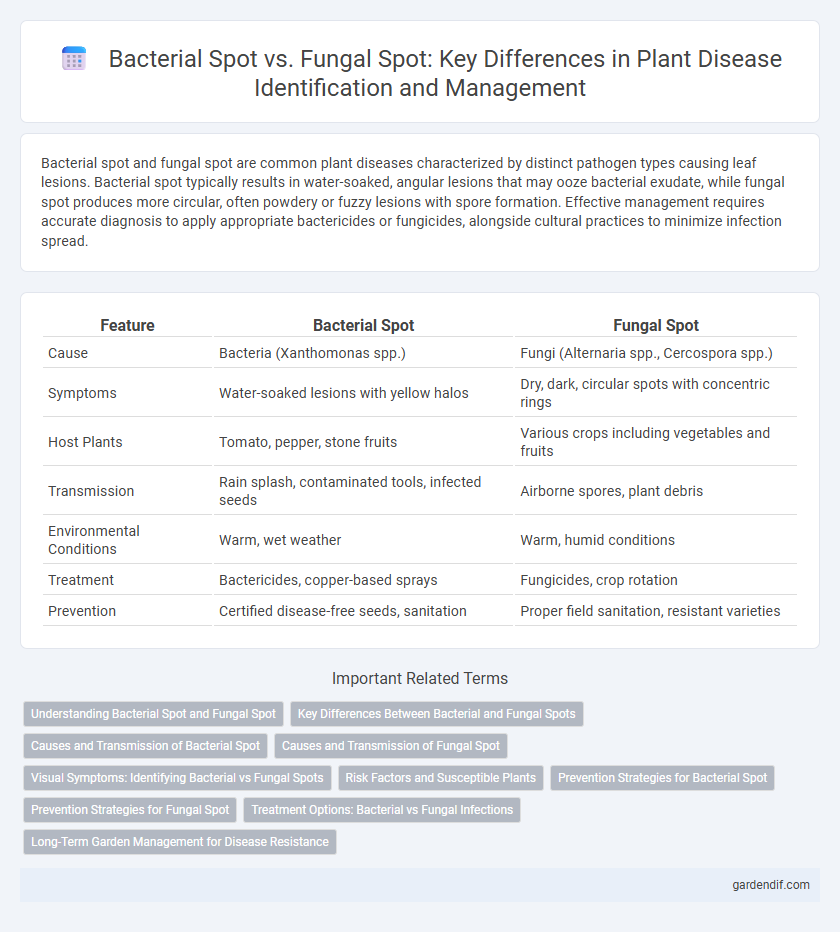
Bacterial spot vs Fungal spot Illustration
Bacterial spot and fungal spot are common plant diseases characterized by distinct pathogen types causing leaf lesions. Bacterial spot typically results in water-soaked, angular lesions that may ooze bacterial exudate, while fungal spot produces more circular, often powdery or fuzzy lesions with spore formation. Effective management requires accurate diagnosis to apply appropriate bactericides or fungicides, alongside cultural practices to minimize infection spread.
Table of Comparison
| Feature | Bacterial Spot | Fungal Spot |
|---|---|---|
| Cause | Bacteria (Xanthomonas spp.) | Fungi (Alternaria spp., Cercospora spp.) |
| Symptoms | Water-soaked lesions with yellow halos | Dry, dark, circular spots with concentric rings |
| Host Plants | Tomato, pepper, stone fruits | Various crops including vegetables and fruits |
| Transmission | Rain splash, contaminated tools, infected seeds | Airborne spores, plant debris |
| Environmental Conditions | Warm, wet weather | Warm, humid conditions |
| Treatment | Bactericides, copper-based sprays | Fungicides, crop rotation |
| Prevention | Certified disease-free seeds, sanitation | Proper field sanitation, resistant varieties |
Understanding Bacterial Spot and Fungal Spot
Bacterial spot is caused by Xanthomonas spp., leading to water-soaked lesions on leaves and fruit, primarily affecting crops like tomatoes and peppers. Fungal spot results from fungal pathogens such as Alternaria spp., characterized by necrotic, dark lesions with concentric rings, commonly seen on various plant hosts. Distinguishing these spots involves examining pathogen type, symptom morphology, and environmental conditions favoring bacterial or fungal growth.
Key Differences Between Bacterial and Fungal Spots
Bacterial spots typically present as water-soaked lesions with irregular margins, often surrounded by yellow halos, while fungal spots are characterized by distinct, circular lesions with well-defined edges and sometimes concentric rings. Bacterial spots frequently exude sticky ooze and spread rapidly in humid, warm conditions, whereas fungal spots develop more slowly and produce spores visible under magnification. Effective management requires identifying the pathogen type since bacterial spots respond to antibiotics or copper-based treatments, whereas fungal spots necessitate fungicides for control.
Causes and Transmission of Bacterial Spot
Bacterial spot is primarily caused by the gram-negative bacterium Xanthomonas campestris pv. vesicatoria, which infects plants through wounds, stomata, or natural openings. Transmission occurs via contaminated seeds, water splashes, and infected plant debris, enabling rapid spread under warm, humid conditions. Unlike fungal spots caused by various fungal pathogens, bacterial spot thrives particularly in moist environments facilitating bacterial colonization and infection.
Causes and Transmission of Fungal Spot
Fungal spot is primarily caused by fungal pathogens such as Alternaria and Septoria species that thrive in warm, humid environments. Transmission occurs through airborne spores that spread via wind, rain splash, and contaminated tools or plant debris, facilitating rapid infection in susceptible plants. Unlike bacterial spot, fungal spot infections often lead to circular lesions with concentric rings and spore-producing structures visible under microscopic examination.
Visual Symptoms: Identifying Bacterial vs Fungal Spots
Bacterial spots typically appear as water-soaked lesions with irregular shapes and yellow halos on leaves, often leading to necrotic centers and leaf distortion. Fungal spots are generally characterized by well-defined, circular lesions with concentric rings or powdery spores on the surface, causing a dry, brittle texture. Differentiating these visual symptoms is crucial for accurate diagnosis and targeted disease management in affected plants.
Risk Factors and Susceptible Plants
Bacterial spot primarily affects tomatoes, peppers, and stone fruits, thriving in warm, wet conditions that facilitate bacterial spread and infection. Fungal spot commonly targets a wider range of plants including roses, beans, and various fruits, with high humidity and poor air circulation increasing fungal spore germination and disease development. Both diseases risk intensifying in overcrowded plantings and environments lacking proper sanitation or crop rotation practices.
Prevention Strategies for Bacterial Spot
Effective prevention strategies for bacterial spot include using certified disease-free seeds, practicing crop rotation with non-host plants, and applying copper-based bactericides early in the growing season. Maintaining proper plant spacing and ensuring good air circulation helps reduce humidity, which limits bacterial proliferation. Sanitizing tools and removing infected plant debris further prevent the spread of bacterial spot pathogens.
Prevention Strategies for Fungal Spot
Effective prevention strategies for fungal spot include crop rotation with non-host plants to disrupt the pathogen lifecycle and reduce soilborne inoculum. Applying fungicides containing active ingredients like chlorothalonil or copper-based compounds before symptom onset helps protect plants from infection. Maintaining proper plant spacing and pruning for improved air circulation reduces humidity, thereby limiting fungal spore germination and disease spread.
Treatment Options: Bacterial vs Fungal Infections
Treatment options for bacterial spot typically involve copper-based bactericides and antibiotics such as streptomycin, while fungal spot requires fungicides containing chlorothalonil or azoxystrobin for effective control. Cultural practices like crop rotation and proper sanitation help minimize both bacterial and fungal infections, but chemical treatments differ due to the distinct pathogen types. Accurate diagnosis is critical to select the appropriate antibacterial or antifungal agents, ensuring targeted disease management and reducing resistance development.
Long-Term Garden Management for Disease Resistance
Long-term garden management for bacterial spot and fungal spot centers on enhancing disease resistance through crop rotation and resistant plant varieties. Proper sanitation, including removing infected plant debris and sterilizing tools, reduces pathogen reservoirs that cause bacterial and fungal infections. Implementing balanced fertilization and maintaining optimal soil moisture further supports plant health and fortifies natural defenses against both bacterial spot and fungal spot pathogens.
Bacterial spot vs Fungal spot Infographic

 gardendif.com
gardendif.com